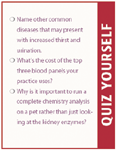Do you know your stuff?
"I'm not the doctor" isn't a reason to not know the answer to these common client concerns. Here's a look at some of the facts everyone should know.
As Mrs. Goodins checks out at ABC Veterinary Hospital, she asks the receptionist what type of treat she should feed her dog, Scooter. The receptionist replies, "It doesn't really matter—as long as you don't give too many." Mrs. Goodins is confused. The doctor recommended a nutritious, low-calorie treat available in the lobby. "I suppose you're right," Mrs. Goodins says. "Scooter, that means one less goodie a day for you." And so the receptionist unwittingly undermines the doctor's recommendation and another dog fails to benefit from a healthier lifestyle change.

Steve Wisbauer/Getty Images
When team members contradict each other, clients lose trust and often seek guidance elsewhere. To support your team's message, you need to know your practice's philosophy and protocols. And the quickest path is through consistent team training, written protocols, role-playing, and testing.
Get everyone on the bus
Imagine you're alone in an exam room with a client. Are you prepared to handle the client's questions? What will you say, and how will you present it? At that moment, you become your practice's ambassador. Training on your practice's protocols and policies is just as important as training on patient care and technical skills.
So what techniques can your team use to ensure everyone shares the right information with clients? First, doctors must agree on recommendations for preferred diets, heartworm and flea and tick preventives, vaccinations, and reproductive surgery. And your team should create policies for identifying obese and painful pets and handling potentially divisive situations, such as requests for convenience euthanasia, clients who can't or won't pay for services, and abandoned pets. Without clear guidelines, doctors and team members may handle situations differently, confusing clients and creating conflict among team members.

Fig. 1
This isn't to say everyone must agree on every topic every time. But you do need to agree on the message you'll present to clients. So put your policy in writing and present a copy to all new team members during their initial phase training. And when you change your team's guidelines, redistribute your policy to all team members. By reinforcing the doctor's recommendations, you'll help clients understand their importance, and they're more likely to comply. And you'll feel confident making care recommendations knowing doctors will support your advice.
Experience is the best teacher
It's difficult to become passionate about something you've only read or heard about. But seeing the benefits of a healthy lifestyle and behavior training in your pet will inspire you to share your experiences with clients. Participating in a dental procedure and reviewing annual blood and urine tests for your pets will give you the perspective that creates trusting communication and encourages clients to comply. So consider this guideline for your practice: Every team member must use the products and services you routinely recommend for clients, such as parasite preventives and yearly dental care and blood work. Clients deserve better than, "Do as I say, not as I do."

Fig. 2
Now I know you're probably thinking, "How can I afford this?" Discuss the possibilities with your managers. If they require you to provide this level of care for your pets, perhaps they'll be willing to offer products or services at a reduced fee. Or maybe they'd even consider providing basic services, such as vaccines, general and dental exams, annual blood and urine tests, and heartworm and flea preventives, as part of your benefit package. And product representatives may be able to offer discounts or complimentary products to help out.
Experience offers a solid framework, and consistent team training gives the right tools to follow through. After all, team members won't come prepackaged with your practice's ideals. So it's up to team leaders to bridge the gap between teaching daily operations and protocols and sharing the practice philosophy.
You might start by taking the top 10 conditions your practice encounters and distilling them into their most common elements, such as clinical signs and affected systems, diagnostic testing, and treatments. Then you can explore recognizing, diagnosing, and treating these conditions in team training sessions. For example, any team member should be able to recognize that kidney disease typically presents with clinical signs of increased thirst and urination. When you understand common illnesses and conditions, you can ask clients questions that will help the doctor diagnose their pets. And the information's also helpful when you explain to clients why their pet might need diagnostic tests.

Fig. 3
Receptionists: You also need to understand this information because you schedule patients' appointments based on the owner's description of the problem. If you know what to ask about pets' symptoms, you'll be able to anticipate the doctor's response and ensure the schedule runs smoothly. For example, if Ms. Dizcreet calls about Damsel's vomiting, diarrhea, and lethargy, you can assume the doctor will want to run blood work and may even take radiographs. Then you can schedule Damsel's appointment to make the best use of your doctor's and team members' time.
Train your team for success
Imagine the 2004 Olympic Marathon winner planned to defend his title by running two or three days in a row two or three times a year. Do you think an athlete who trains this way has much chance of staying at the top of his game? Unlikely. Yet this is exactly how many people approach their professional continuing education. Doctors and technicians rationalize they spent years preparing for their professions and they can maintain their technical prowess by attending a couple of conferences or reading a few journal articles a year. It's much more effective to create systems that encourage regular learning, including weekly team training, reviewing research papers, and routinely attending conferences.
If you're a trainer or leader, start by identifying the topics your practice encounters daily. Focus on subjects such as vaccinations and contagious diseases, heartworm disease, diet, obesity, type 2 diabetes, reproductive surgeries, allergic dermatitis, otitis externa, and colitis. Prepare written summaries, listen to doctors discuss recent cases at your practice, role-play discussing the information with clients, and take tests to ensure everyone understands the material.
Begin role-playing exercises by asking a doctor or senior team member to demonstrate a scenario you want to explore. Once team members see how they should respond, incorporate newer team members into the exercise. For example, a senior team member acts as a client and the new team member handles a patient that presents with the signs and symptoms of kidney disease.
Then it's time to test. View tests as a reflection of your training system, rather than your test-taking abilities. These quizzes will show what you've learned—and where doctors and team leaders can go further to offer you the tools you need to educate clients.

Fig. 4
What about new hires? You can't expect them to possess the same knowledge or experience as senior team members, but you can offer training to help them get there. Phase training eases new hires into your practice without overwhelming them with the great amount of information that flows through a practice. You provide intermediate goals for guidance and offer written goals at every training level. Then senior team members and doctors evaluate new employees at each level before they advance to the next one.
Prep for the money talk
Senior team members know feeling comfortable discussing your practice's financial policy is important for successful client communication. So practice providing general estimates for common procedures and conditions.
Paperless medical records and computers in exam rooms may help you provide accurate estimates. Just make sure you project confidence. Otherwise, clients may feel intimidated or offended or falsely perceive your practice is more interested in money than caring for pets.
Role-playing tough situations, such as when clients may not be able to afford the recommended services, helps you feel comfortable and exude compassion in these trying situations.
Create a culture of consistency
Once your team defines learning objectives and outlines guidelines for basic veterinary care, you need to practice. Remember, clients are more likely to comply if you present a consistent message. Your team must decide what your practice stands for, construct a mission statement, and build from this foundation. Just as each state has a veterinary medical practice act, each practice should write rules for the team to follow. For example, how do you approach clients when you first encounter their obese dog? What care plan do you recommend? Discuss these situations to produce a unified message. And create systems that allow a natural transition from one team member to another and strengthen your recommendation.
Keep in mind there's no room for super stars. Some team members boost their self-esteem by outperforming others. While these people may feel exceptional, clients view them as part of a team that's sub-par. The most valuable team members strive to elevate their entire team—even if it means less recognition for themselves.

Fig. 5
Your team in tune
When you practice a consistent message, you build team harmony. There's little opportunity to undermine or contradict other team members because everyone knows the expectations. No one is afraid to offer a suggestion because they know the advice to offer. Receptionists know technicians will support what they tell clients, and doctors trust team members to enforce their practice's protocols. The team unites to provide the best care for patients and the best service for clients.
When you know your stuff, you know what your practice stands for and how you're expected to communicate with clients and care for patients. Consistency is the first step toward creating credibility with clients—and enjoying a cohesive team in a nurturing workplace.
Ernest E. Ward Jr., DVM, is the owner of Seaside Animal Care in Calabash, N.C. In his spare time, Dr. Ward runs marathons and participates in Ironman competitions. He will share his experiences to help your team develop a consistent approach to patient care and client communication at Firstline Live on Aug. 22 in Kansas City, Mo. Regina Toman is a Firstline Editorial Advisory Board member and a veterinary assistant at Seaside Animal Care. She enjoys swimming, diving, and pizza and lives with three dogs and two cats. Please send questions or comments to firstline@advanstar.com

Ernest E. Ward Jr.

Regina Toman